
“The Balanced Scorecard (BSC) provides managers with the instrumentation they need to navigate to future competitive success.”
Robert S Kaplan
How can you determine if your organization’s strategy is working? If your balanced scorecard doesn’t include performance measures, how will you know if it’s working or not? This blog post will explore the two different approaches to performance measurement–the Strategy Map and the Balanced Scorecard–to help you answer those questions.
The basics of strategy map
Strategy map illustrate a logical, cause-and-effect relation among strategic objectives. A visual representation of how all components of a company’s strategy fit together. The chart, also known as a strategic alignment chart, allows teams to visualize their goals and strategies in relation to one another.
It is important for an organization because it provides leaders with a roadmap, or implementation roadmap, of their strategy (A is not successful without B). We can use a strategy map to:
- Focus on strategy and results
- Increasing Organizational Performance by Measuring What Matters
- Align People’s Day-to-Day Work with Strategy
- Focus On Future Performance Drivers
- Enhance the company’s vision and strategy communication
A balanced scorecard framework can provide insight into how well those strategies are being implemented (see what makes up both) and allow organizations to better understand their strengths and weaknesses so they can improve upon them. This helps create a sustainable advantage over competitors by giving companies more control over their own destiny.
Strategy maps help leaders gain clarity on organizational strategy by connecting its vision, mission, values, goals and objectives to key business processes such as customer satisfaction, quality management and innovation management.
Examples
Every company is unique, and there is no one-size-fits-all approach to creating an effective strategy map.
For example, most businesses prioritize the financial perspective because their ultimate purpose is to increase profits. The motivations of public utilities and NGOs, on the other hand, are very different. Their financial situation is merely a means to an end. The ultimate purpose of a nonprofit organization is to provide the greatest services possible. It’s usual for these businesses to reverse the Customer and Financial perspectives, putting the Customer first.
It’s crucial to keep in mind that your strategy map should reflect your organization’s actual plan. It’s perfectly OK to depart from the typical arrangement in order to meet your specific objectives.
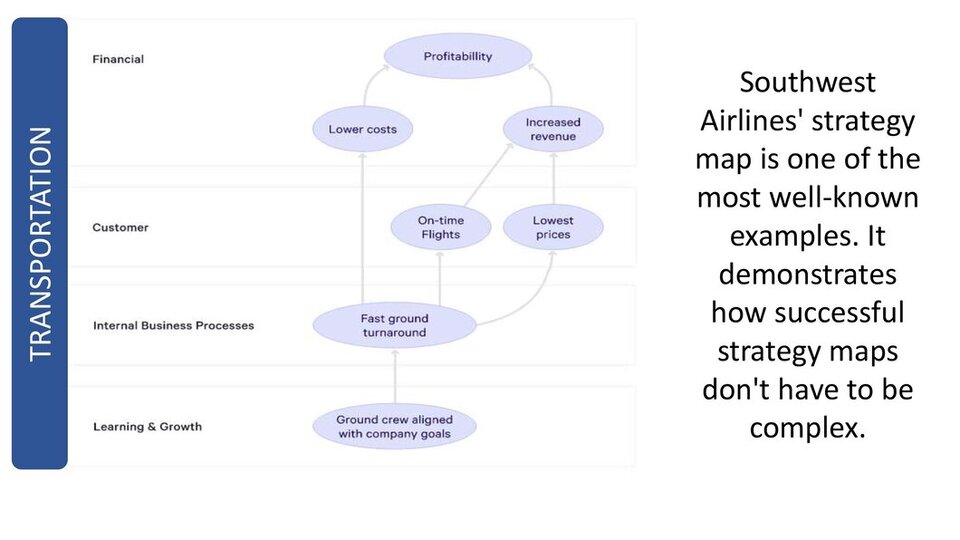

Building a balanced scorecard for your company
The balanced scorecard is a management technique created by Robert Kaplan and David Norton to assist firms in achieving their business goals and implementing critical strategies. It helps organizations prioritize what’s important.
The process of building a balanced scorecard is fairly straightforward, but it can help companies both clarify their vision as well as measure their performance. How do you build one? There are different ways, but one commonly used approach is called a balanced scorecard framework.
With these frameworks, there are three major components that define an organization’s direction. These include strategic objectives, current status (or key results areas), and leading indicators of those key results areas (KRAIs). This framework creates four perspectives on which any company can base its improvement efforts.
Those perspectives are financial, customer, internal business processes, and learning & growth. Each perspective includes a set of metrics or KRAIs to track progress toward achieving goals in each area.
“A Balanced Scorecard helps turn parrots – people who just repeat what they have heard – into ambassadors – people who understand the what and why and can reason decisions with others”
The first step in building a balanced scorecard is identifying what your top priorities are for your business over the next year or two. For example, if you want to increase profits by 15 percent over the next year, then identify how you will achieve that goal—what steps will lead to success?
Once you have identified some strategies for improving certain parts of your business based on your goals and priorities, then it’s time to develop KRAIs—key result areas—that will tell you whether or not each goal has been achieved.
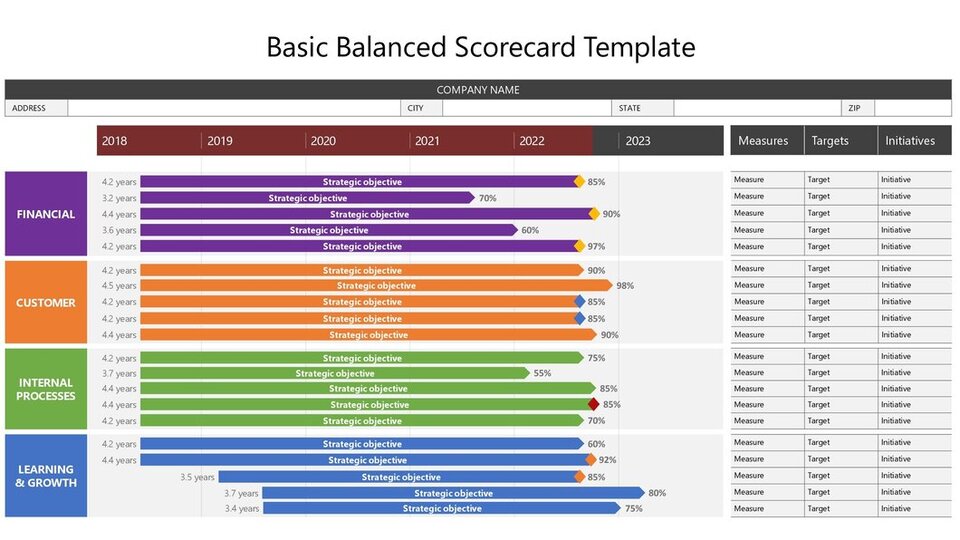
Example
Nike’s main business is to design, develop, manufacture, and market high-quality footwear, clothing, equipment, and accessories all over the world. NIKE is the world’s leading retailer of athletic footwear and apparel. Nike is recognized in over 120 countries with a combination of independent distributors and subsidiaries.
Below is the balanced scorecard of Nike, Inc. and outlines the customers, financial, process, as well as the learning and growth perspectives
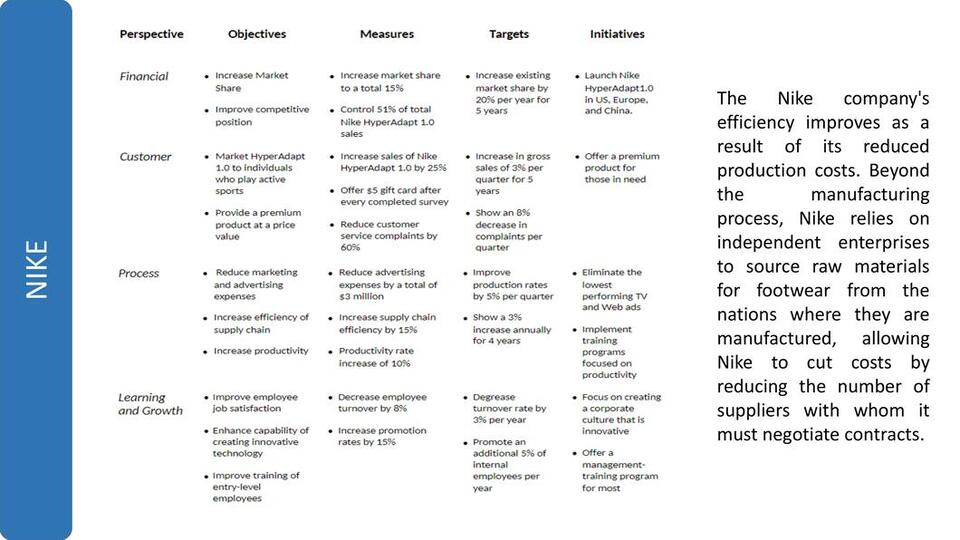
What Are the Steps to Creating a Strategy Map?
A Strategy Map is a visual representation of your strategy that conveys its story. It graphically depicts how you intend to add value to the organization for your customers. This chart portrays the strategic objectives to be focused on in the form of perspectives and causal arrows, and provides simple visual representations of what it is you believe will drive change.
The strategy map has been proven to be helpful in facilitating discussion among management teams about which objectives to choose, as well as in facilitating discussion of actual performance. The following stages can be used to create a strategy map:
- It is a framework based on horizontal perspectives arranged in cause and effect relationships, typically financial, customer, process, and learning and growth.
- Within those perspectives, there are several goals. Each goal is represented by text inside a shape.
- Vertical groups of interconnected objectives that span multiple perspectives. These are referred to as strategic themes.
- Across the perspectives, there are clear cause-and-effect relationships between these objectives.
- Hypotheses relating to how the strategy will influence the outcomes of the organization are contained in the Strategic Themes.
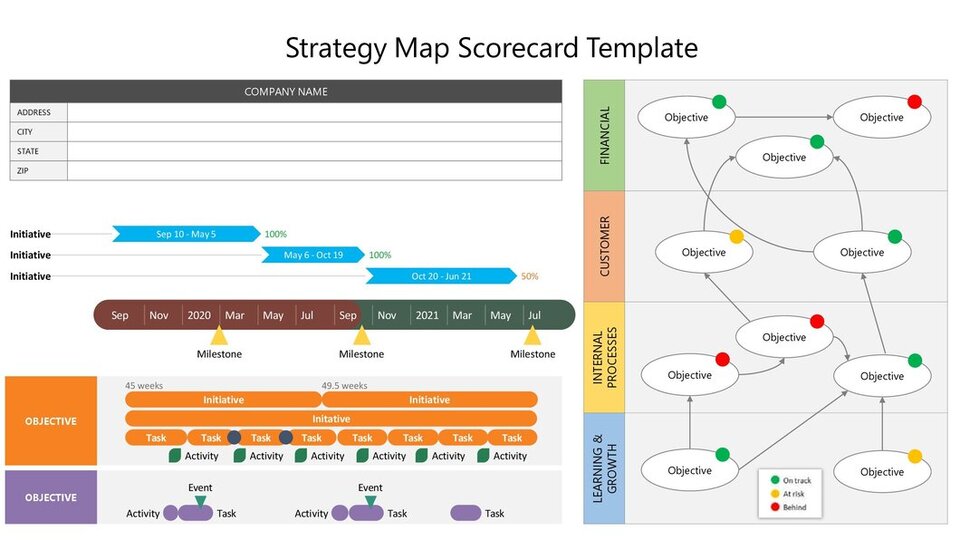
Combining balanced scorecards and strategy maps
An effective way of setting a company’s priorities and monitoring results over time is through a combination of an organization’s balance scorecard (BSC) and its strategy map. A BSC lists all of an organization’s goals, including financial, operational, human resource, customer-service/client, quality improvement goals; a BSC indicates progress toward these goals by using balanced metrics or key ratios.
For example, total shareholder return (TSR) is one such metric in measuring performance against shareholder objectives; return on assets (ROA) can be used as a ratio for assessing how well management turns resources into profits. The strategy map provides a visual representation of how each goal relates to others within an organization.
The aim is to achieve alignment between strategic goals and organizational capabilities. This ensures that employees understand what they are supposed to do at every level in order to achieve their goals. In addition, it allows senior managers and board members alike to evaluate whether there are any gaps between what has been planned and what has been achieved, thus enabling them to take corrective action if necessary.
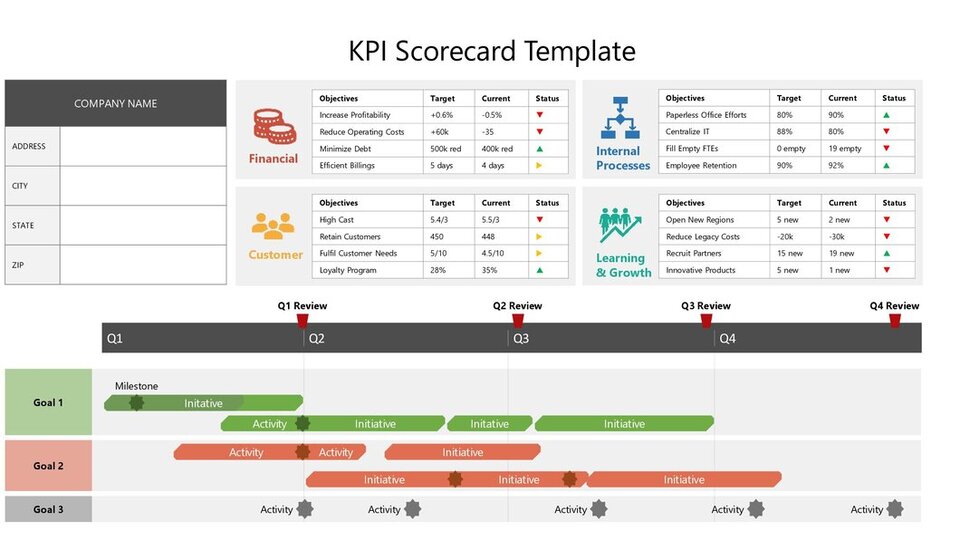
How can I share this with others in my team/organization?
You can conduct a series of quarterly town hall meetings to ensure that everyone is on board with your new plan. At these sessions, your top performers can give their thoughts on how successfully you are implementing your strategy. These meetings need to be well documented and reviewed by teams across organizations so they can assess where they need to improve.
You can also introduce an internal scorecard framework that tracks how each department contributes towards achieving overall company goals. Plan to formalize communication around these measures every month by sharing them via email with other members of your staff. This way, everyone has access to essential information about how well you’re doing against your goals in a centralized place that everyone can access at any time.
Takeaways
The most important thing to remember about your strategy map is that it will look different based on how the organization wishes to arrange its viewpoints and objectives. The document could be very imaginative or quite straightforward. There is no wrong method to begin constructing a map as long as the organization has clearly established its strategy with its mission, vision, and values and is using those statements as a guide.
When planning your strategy, keep the following in mind:
- Problems aren’t solved by strategic planning. Try and improve the company’s chances of success.
- The fundamental goal of strategic maps is to establish the manner in which the enterprise wishes to position itself in the market, taking into account the demands and preferences of the target clients.
- Use strategies to attract and retain clients and markets.
- Make a compelling value proposition for your target market.
- Keep your map to one page and just contain the most critical selections for the company’s revenue drivers.
- Make a list of the procedures that need to be changed in your company to meet the major strategic aim.


